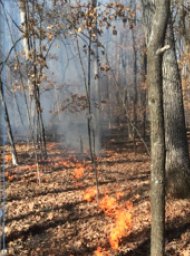AgEBB-MU CAFNR Extension
Green Horizons
Volume 20, Number 1
January 2016
Returning Fire to Forest Management Part 1: History and the RubBy Michael C. Stambaugh, Red. Assistant Professor, Forestry, University of Missouri
Daniel C. Dey, Research Forester, U.S. Forest Service
Think about the vast changes in technology, economics, and communication that have occurred during the last century. Changes in forest management have also occurred including perspectives on, and use of fire. Recently, natural resource professionals have begun to realize that fire can be beneficial when used carefully to meet specific objectives. As with any change, it may be difficult for some to understand why fire use is being promoted and how to judge its benefits and costs. This article is part 1 of 3 that addresses emerging issues related to fire and forest management. To do this, we will report on the history of fire, challenges & opportunities in fire use, and potential future directions related to fire and land management.
Fire History
Fire is a chemical reaction that has been occurring on earth since the appearance of plants. Through time, many plants and animals have become adapted to, or dependent upon, fire to survive. In the Midwest, fossil charcoal records that extend back to the last glaciation show evidence of recurring fires, including its presence in upland forests. Lightning-caused fires are uncommon in the Midwest, so humans are considered as the primary source of fire for thousands of years. There are dozens of reasons why humans burn vegetation to "manage" land including: hunting, site preparation and management for crops (both native and domesticated), improving growth and yield of plants, fireproofing areas, cooking, felling trees, clearing land for travel, warfare, signaling, etc. Fire was so pervasive in the past that you would not recognize familiar places if you could turn back the clock 100 years or more.
Fire was the primary factor that created the types, locations, and conditions of forests that were first encountered by European settlers and, like the Native Americans, early European settlers lived off the land in a system of subsistence based on livestock and crop production using fire to manage land for their benefit. During settlement, forests may have burned more frequently than grasslands because more forage for livestock was needed than was available. Due to massive wildfires in the early part of the 20th century due to large scale forest mismanagement, beginning around the 1930s, great efforts were made to stop burning by state and federal agencies. By the 1950s, burning in forests had essentially ceased. Stopping forest fires resulted in a loss of knowledge of managing land with fire. Today, society's knowledge of fire is less essential. Many of the goods and services provided by fire in the past have been repackaged and are now provided by stove tops, heaters, and combustion engines. However, suppressing fire has caused dramatic changes in forests throughout the United States. Due to the lack of fire, many species and forest types have been diminished or lost. States like Missouri are more heavily forested than they were 150 or more years ago. Most alarming is that oak and hickory forests are declining throughout the eastern U.S. Scientists attribute this broad decline to the lack of disturbance, particularly to the lack of fire. In response, there is increased interest in understanding how to return fire to forest management... but there is a rub.
 |
The Rub
Forest values have changed over time. The values that Native Americans and European settlers had are not the same as today's values. Though some values have remained the same and are still enhanced by burning, others can be diminished, such as commercial timber value and production - and here lies the rub. Fire disturbance is needed, but may not align with all of the values placed on present day forests. The challenge is to re-learn fire management and determine how the use of fire can be placed back into forest management to enhance certain values while minimizing the negative effects on others.
For more information about fire science and management, visit Oak Woodlands & Forests Fire Consortium webpage at www.oakfirescience.com, or, stay tuned for the next two issues of Green Horizons.
